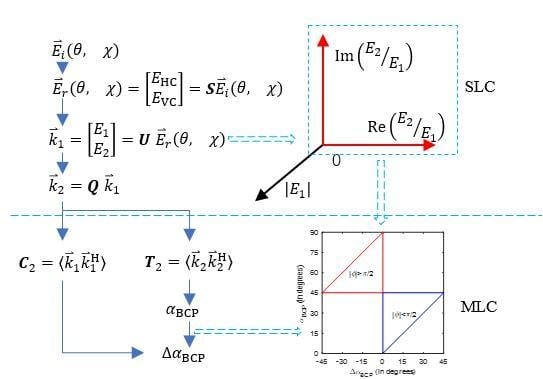Oil Spill Discrimination by Using General Compact Polarimetric SAR Features
Abstract
1. Introduction
2. The General Compact Polarimetric Features
2.1. Formalism of the General CP Descriptors
2.2. Polarization Ratio-Based Decomposition for the General CP Images
3. Experiments
3.1. Test Data Sets
3.2. Oil Spill Detection
4. Conclusions
Author Contributions
Funding
Conflicts of Interest
References
- Sandven, S.; Hamre, T.; Babiker, M.; Kloster, K.; Hansen, M.; Wåhlin, J.; Kudryavtsev, V.; Myasoedov, A.G.; Alexandrov, V.; Melentyev, V.V.; et al. MONRUK SAR Data Analysis Report; NERSC Technical Report no. 310; Nansen Environmental and Remote Sensing Center: Bergen, Norway, 2005–2007.
- Alpers, W.; Espedal, H.A. Chapter 11 oils and surfactants. In Synthetic Aperture Radar Marine User’s Manual; NOAA: Washington, DC, USA, 2004; pp. 263–277. [Google Scholar]
- Crisp, D.J. The State-Of-The-Art In Ship Detection In Synthetic Aperture Radar Imagery; Defence Science and Technology Organization (DSTO), Information Sciences Laboratory: Edinburgh, SA, Australia, 2004. [Google Scholar]
- Souyris, J.C.; Imbo, P.; Fjørtoft, R.; Mingot, S.; Lee, J.-S. Compact polarimetry based on symmetry properties of geophysical media: the π/4 mode. IEEE Trans. Geosci. Remote Sens. 2005, 43, 634–646. [Google Scholar] [CrossRef]
- Nord, M.; Ainsworth, T.; Lee, J.-S.; Stacy, N. Comparison of compact polarimetric synthetic aperture radar modes. IEEE Trans. Geosci. Remote Sens. 2009, 47, 174–188. [Google Scholar] [CrossRef]
- Collins, M.; Denbina, M.; Atteia, G. On the reconstruction of quad-pol SAR data from compact polarimetry data for ocean target detection. IEEE Trans. Geosci. Remote Sens. 2013, 51, 591–600. [Google Scholar] [CrossRef]
- Li, Y.; Zhang, Y.; Chen, J.; Zhang, H. Improved compact polarimetric SAR quad-pol reconstruction algorithm for oil spill detection. IEEE Geosci. Remote Sens. Lett. 2014, 11, 1139–1142. [Google Scholar] [CrossRef]
- Yin, J.; Yang, J. Multi-polarization reconstruction from compact polarimetry based on modified four-component scattering decomposition. J. Syst. Eng. Electron. 2014, 25, 399–410. [Google Scholar] [CrossRef]
- Yin, J.; Moon, W.M.; Yang, J. Model-based pseudo-quad-pol reconstruction from compact polarimetry and its application to oil-spill observation. J. Sens. 2015, 2015, 1–8. [Google Scholar] [CrossRef]
- Yin, J.; Papathanassiou, K.; Yang, J.; Chen, P. Least-squares estimation for pseudo quad-pol image reconstruction from linear compact polarimetric SAR. IEEE J. Sel. Topics Appl. Earth Observ. Remote Sens. 2019, 12, 3746–3758. [Google Scholar] [CrossRef]
- Raney, R.K. Hybrid-polarity SAR architecture. IEEE Trans. Geosci. Remote Sens. 2007, 45, 3397–3404. [Google Scholar] [CrossRef]
- Raney, R.K.; Cahil, J.T.S.; Patterson, G.W.; Bussey, D.B.J. The M-Chi decomposition of hybrid dual-polarimetric radar data. In Proceedings of the IEEE International Geoscience and Remote Sensing Symposium, Munich, Germany, 22–27 July 2012; pp. 5093–5096. [Google Scholar]
- Charbonneau, F.J.; Brisco, B.; Raney, R.K.; McNairn, H.; Liu, C.; Vachon, P.W.; Shang, J.; DeAbreu, R.; Champagne, C.; Merzouki, A.; et al. Compact polarimetry overview and applications assessment. Can. J. Remote Sens. 2010, 36, S298–S315. [Google Scholar] [CrossRef]
- Cloude, S.; Goodenough, D.; Chen, H. Compact decomposition theory. IEEE Geosci. Remote Sens. Lett. 2012, 9, 28–32. [Google Scholar] [CrossRef]
- Yin, J.; Yang, J.; Zhou, Z.-S.; Song, J. The extended Bragg scattering model-based method for ship and oil-spill observation using compact polarimetric SAR. IEEE J. Sel. Top. Appl. Earth Obs. Remote Sens. 2015, 8, 3760–3772. [Google Scholar] [CrossRef]
- Shirvany, R.; Chabert, M.; Tourneret, J.-Y. Ship and oil-spill detection using the degree of polarization in linear and hybrid/compact dual-pol SAR. IEEE J. Sel. Top. Appl. Earth Observ. Remote Sens. 2012, 5, 885–892. [Google Scholar] [CrossRef]
- Pablo, C.-C.; Yan, X.-H. Low-backscatter ocean features in synthetic aperture radar imagery. Johns Hopkins APL Tech. Dig. 2000, 21, 116–121. [Google Scholar]
- Gade, M.; Alpers, W.; Hühnerfuss, H.; Wismann, V.R.; Lange, P.A. On the reduction of the radar backscatter by oceanic surface films: scatterometer measurements and their theoretical interpretation. Remote Sens. Environ. 1998, 66, 52–70. [Google Scholar] [CrossRef]
- Solberg, A.H.S. Remote Sensing Of Ocean Oil-Spill Pollution; Institute of Electrical and Electronics Engineers: Piscataway, NJ, USA, 2012; Volume 100, pp. 2931–2945. [Google Scholar]
- Schuler, D.L.; Lee, J.-S. Mapping ocean surface features using biogenic slick-fields and SAR polarimetric decomposition techniques. IEE Proc. -Radar Sonar Navig. 2006, 153, 260–270. [Google Scholar] [CrossRef]
- Nunziata, F.; Sobieski, P.; Migliaccio, M. The two-scale BPM scattering model for sea biogenic slicks contrast. IEEE Trans. Geosci. Remote Sens. 2009, 47, 1949–1956. [Google Scholar] [CrossRef]
- Kim, D.-J.; Moon, W.M.; Kim, Y.-S. Application of TerraSAR-X data for emergent oil-spill monitoring. IEEE Trans. Geosci. Remote Sens. 2010, 48, 852–863. [Google Scholar]
- Migliaccio, M.; Nunziata, F.; Gambardella, A. Polarimetric signature for oil spill observation. In Proceedings of the 2008 IEEE/OES US/EU-Baltic International Symposium, Tallinn, Estonia, 27–29 May 2008; pp. 1–5. [Google Scholar]
- Nunziata, F.; Gambardella, A.; Migliaccio, M. On the Mueller scattering matrix for SAR sea oil slick observation. IEEE Geosci. Remote Sens. Lett. 2008, 5, 691–695. [Google Scholar] [CrossRef]
- Migliaccio, M.; Gambardella, A.; Nunziata, F.; Shimada, M.; Isoguchi, O. The PALSAR polarimetric mode for sea oil slick observation. IEEE Trans. Geosci. Remote Sens. 2009, 47, 4032–4131. [Google Scholar] [CrossRef]
- Nunziata, F. Single- and Multi-Polarization Electromagnetic Models for SAR Sea Oil Slick Observation. Ph.D. Thesis, Parthenope University of Naples, Naples, Italy, December 2008. [Google Scholar]
- Velotto, D.; Migliaccio, M.; Nunziata, F.; Lehner, S. Dual-polarized TerraSAR-X data for oil-spill observation. IEEE Trans. Geosci. Remote Sens. 2011, 49, 4751–4762. [Google Scholar] [CrossRef]
- Yin, J.; Papathanassiou, K.; Yang, J. Formalism of compact polarimetric descriptors and extension of the ∆αB/αB method for general compact-pol SAR. IEEE Trans. Geosci. Remote Sens. 2019, 57, 10322–10335. [Google Scholar] [CrossRef]
- Lee, J.-S.; Pottier, E. Polarimetric Radar Imaging from Basics to Applications; CRC Press: Boca Raton, FL, USA, 2009; pp. 31–98. [Google Scholar]
- Yin, J.; Moon, W.M.; Yang, J. Novel model-based method for identification of scattering mechanisms in polarimetric SAR data. IEEE Trans. Geosci. Remote Sens. 2016, 54, 520–532. [Google Scholar] [CrossRef]
- Yin, J.; Yang, J.; Zhang, Q. Assessment of GF-3 polarimetric SAR data for physical scattering mechanism analysis and terrain classification. Sensors 2017, 17, 2785. [Google Scholar] [CrossRef] [PubMed]
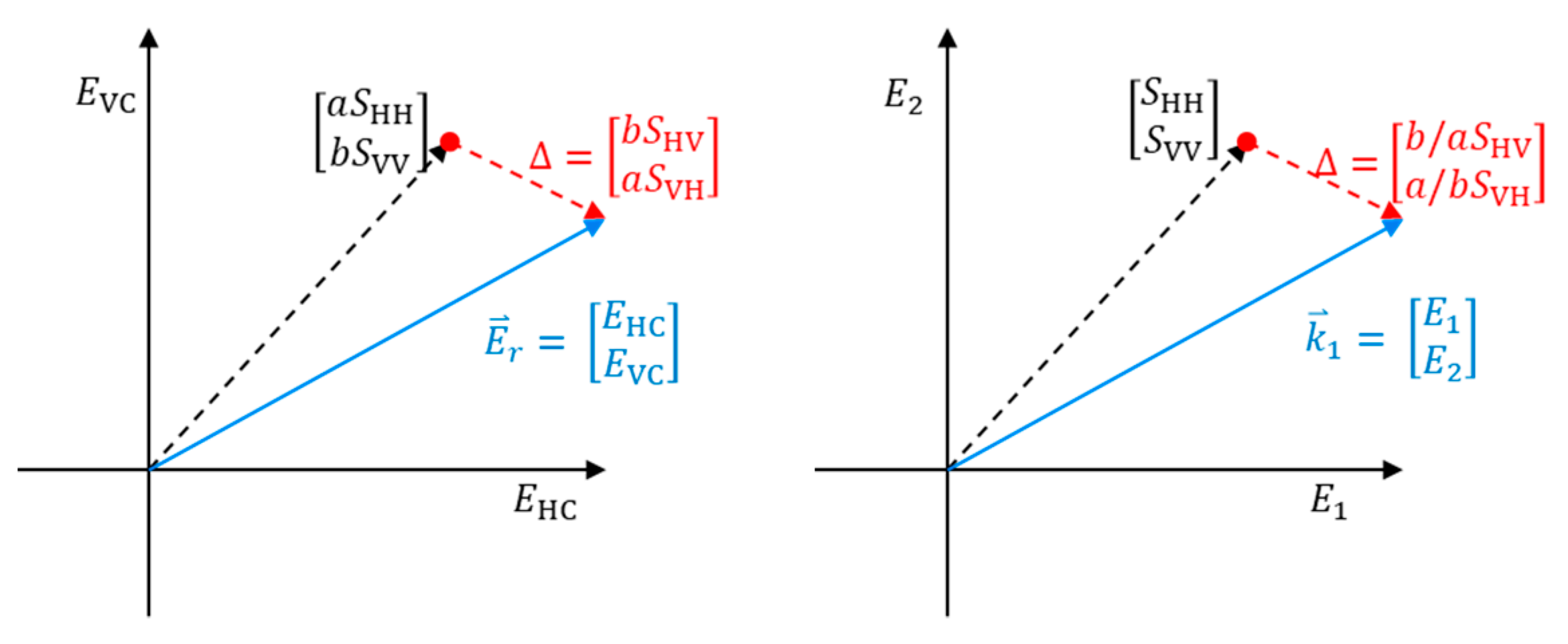
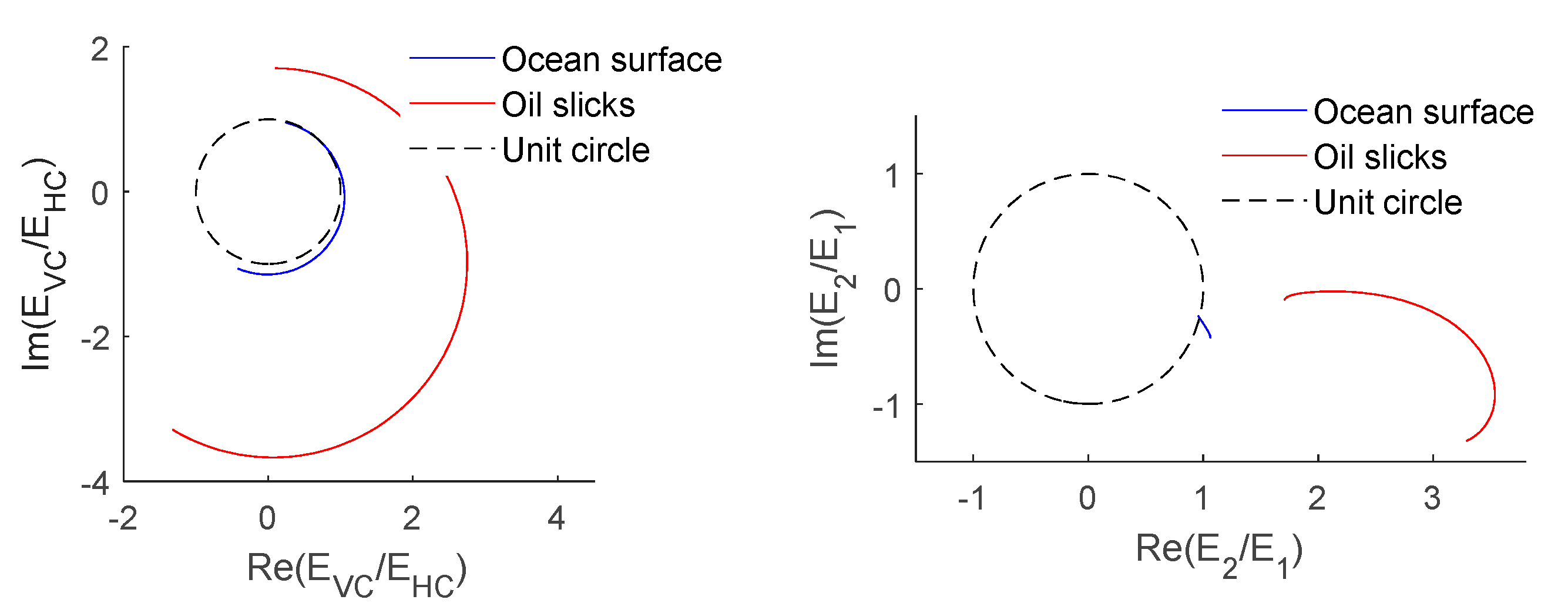
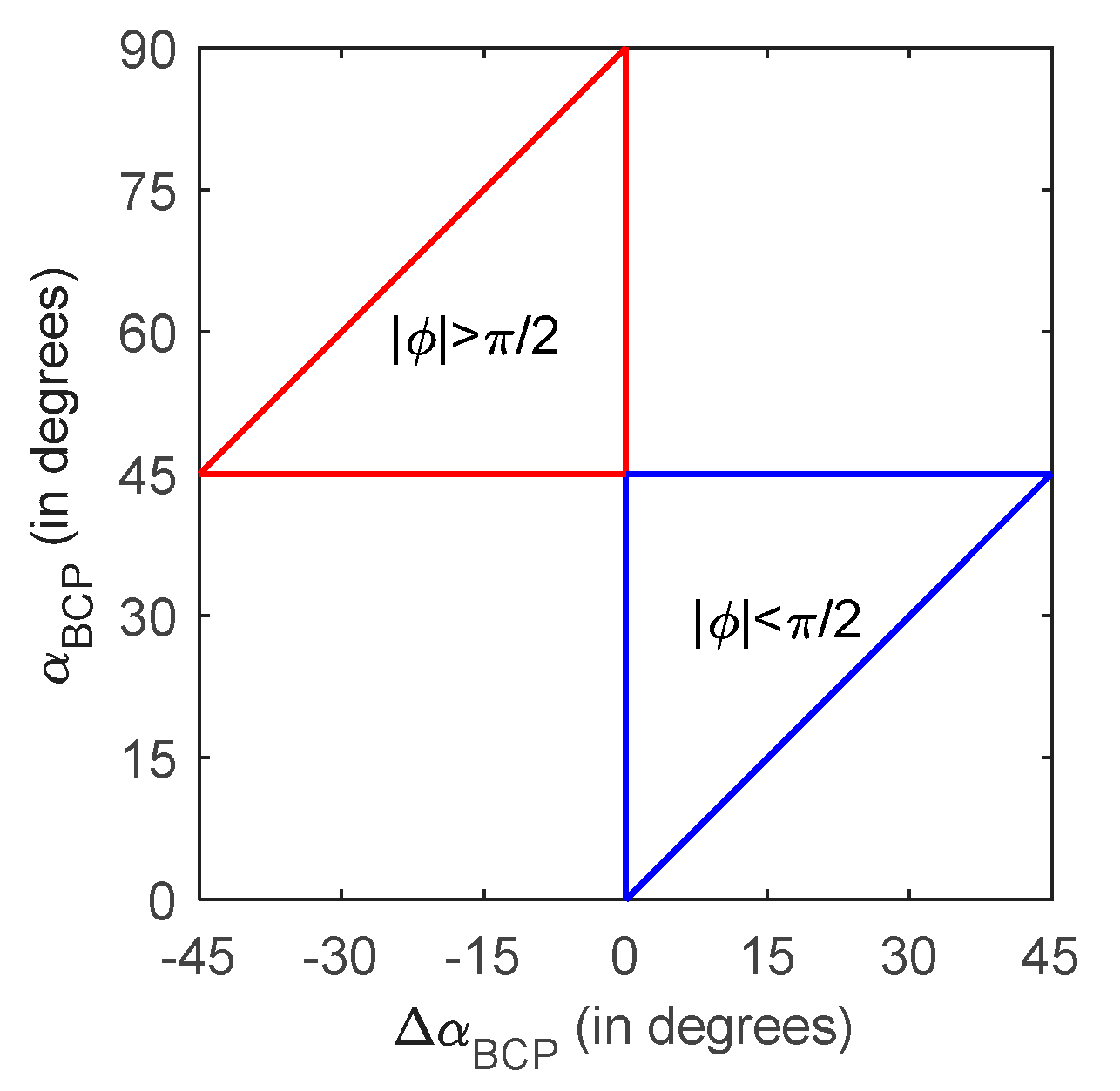
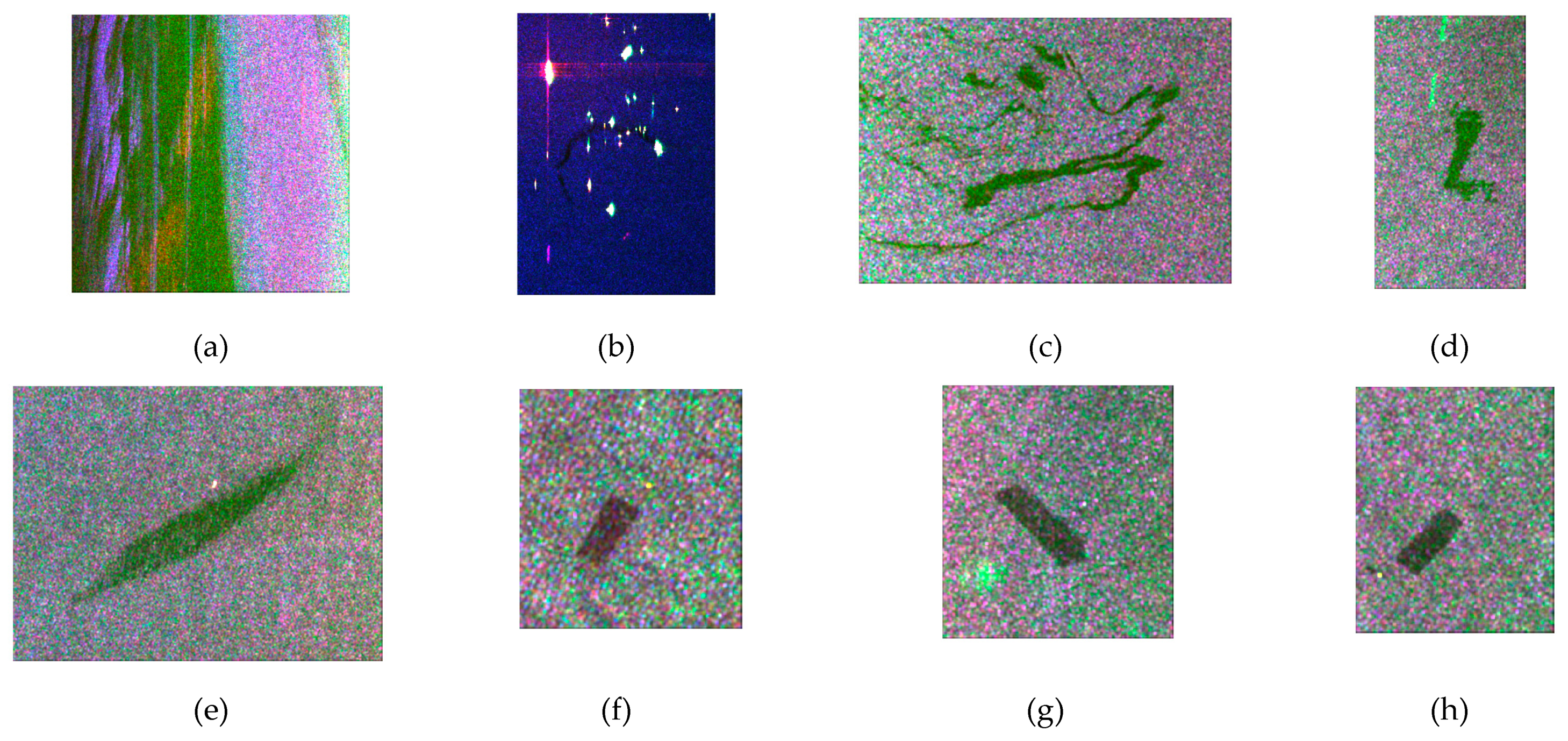
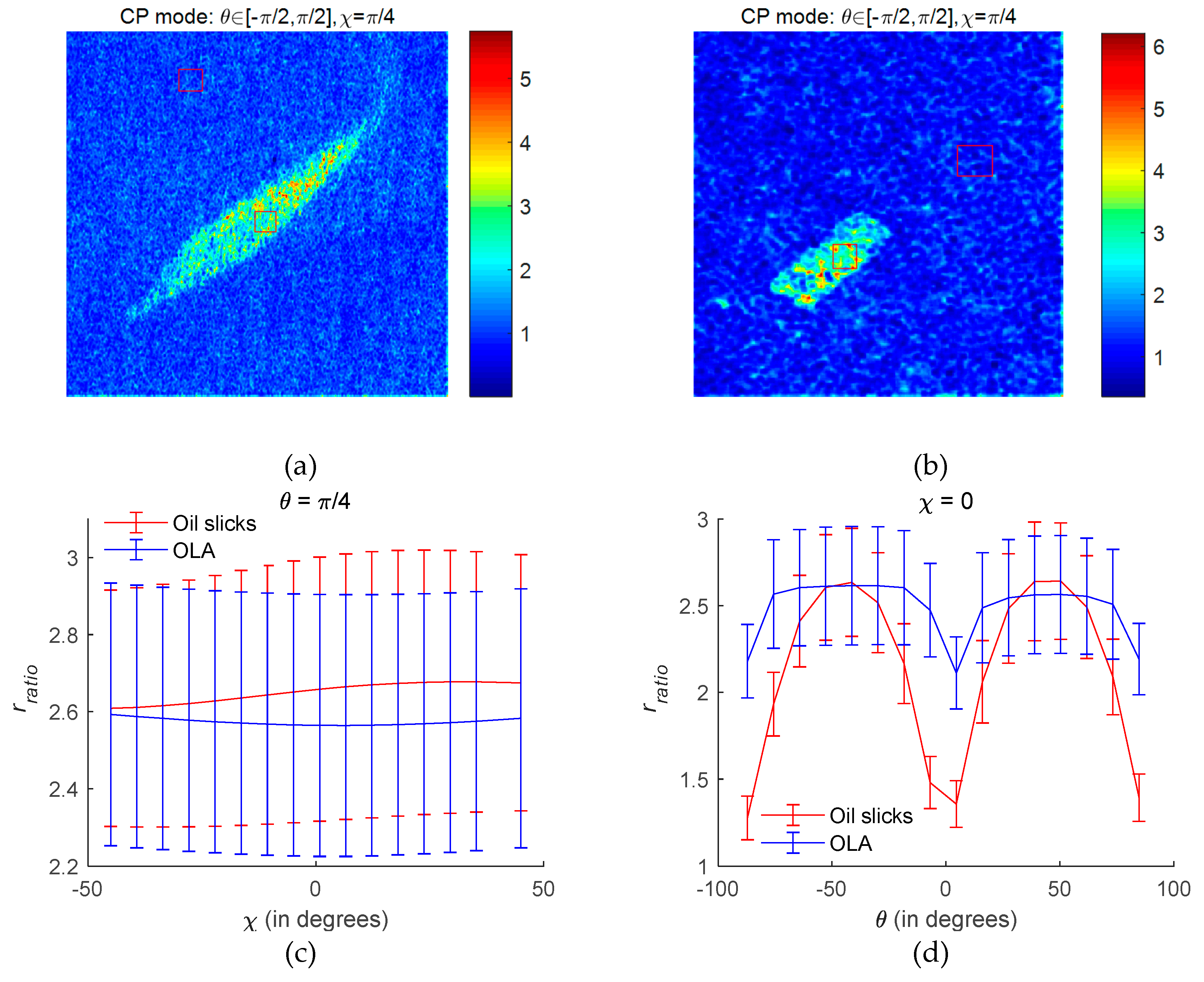
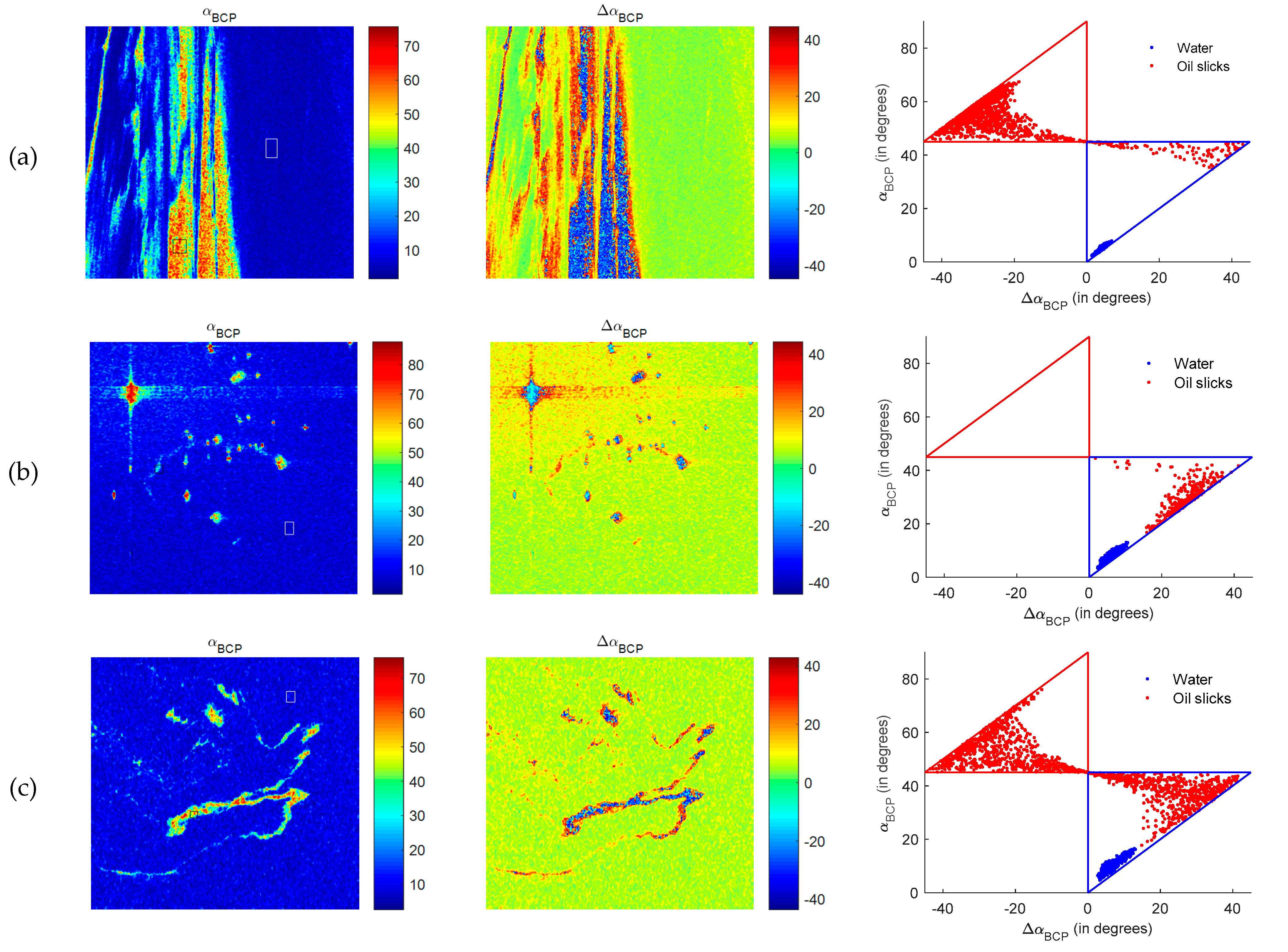
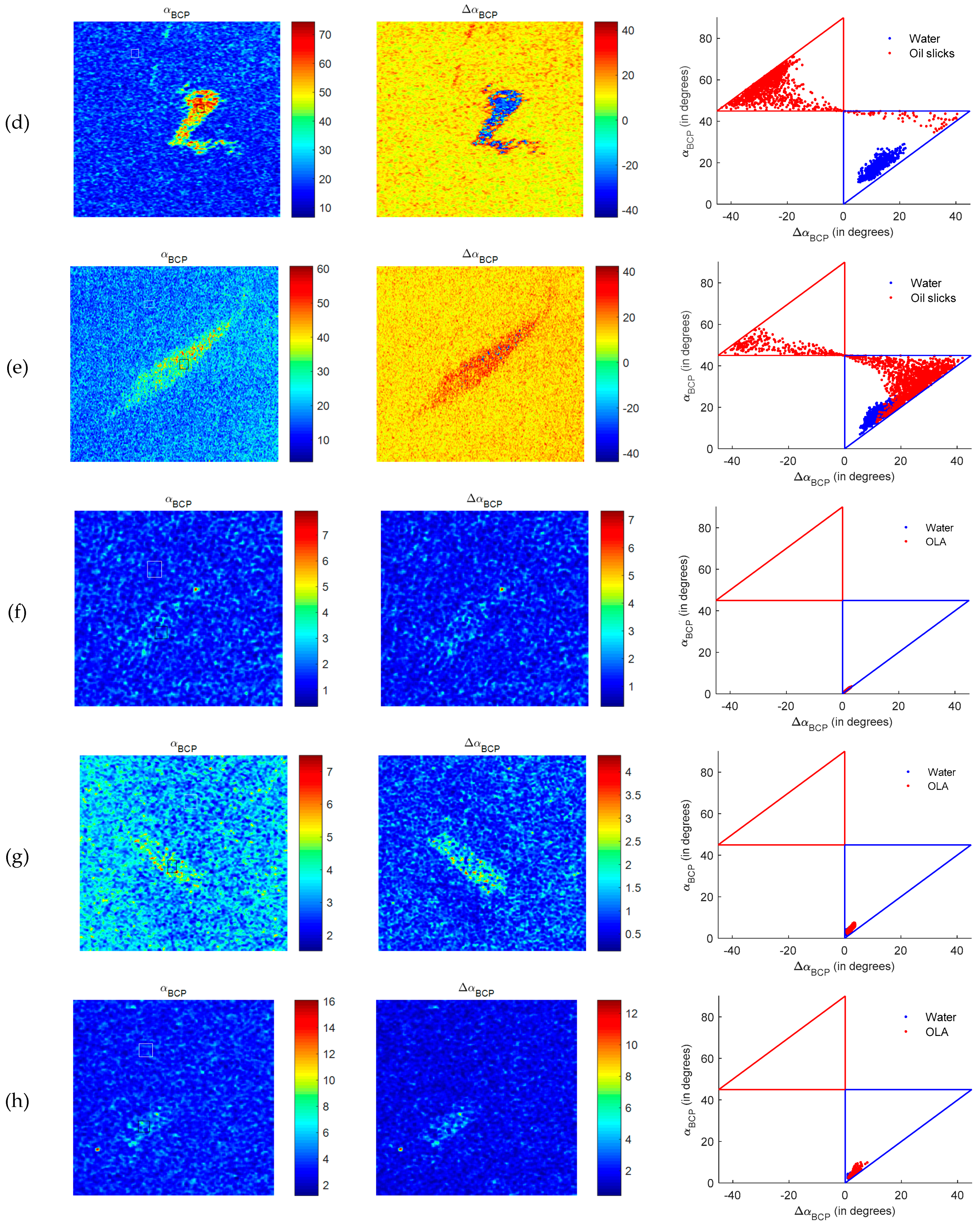

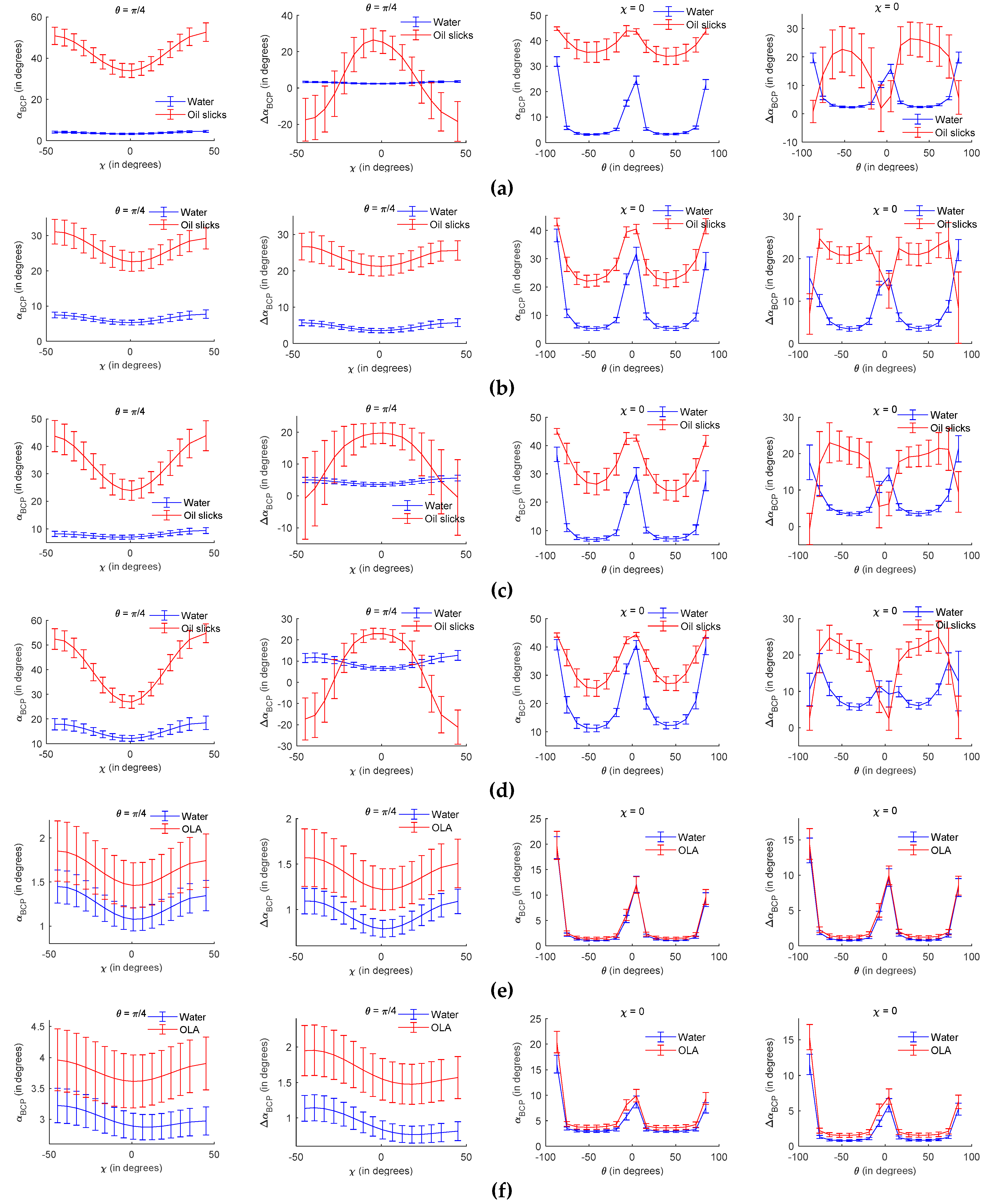
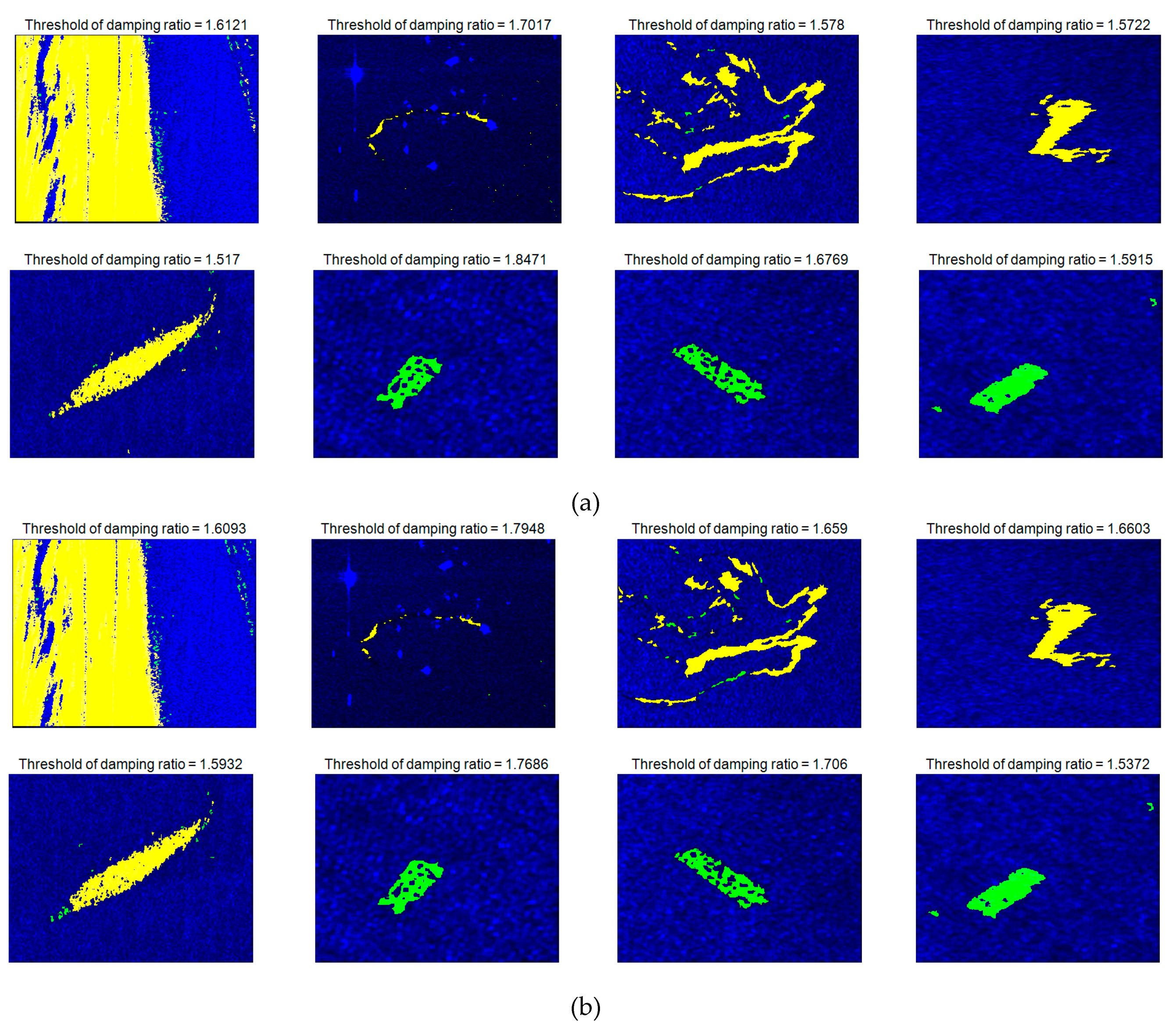
| Sensor | Location or Site Identification | Pixel Spacing (in meters) | Incidence Angle (in degrees) | Acquisition Date | Object |
|---|---|---|---|---|---|
| ALOS/PALSAR-1 | ALPSRP031440190 | 4.5*9.5 | Center: 25.7° | 2006-8-27 | Oil slicks |
| RADARSAT-2 | Penglai 19-3 oilfield, Bohai bay | 4.7*5.5 | 36.5°–38.0° | 2011-8-19 | Oil slicks |
| SIR-C/X-SAR | p.n. 17041 | 12.5*12.5 | 35.4°–40.4° | 1994-4-11 | Oil slicks |
| SIR-C/X-SAR | p.n. 44327 | 12.5*12.5 | 44.1°–47.5° | 1994-10-1 | Oil slicks |
| SIR-C/X-SAR | p.n. 49939 | 12.5*12.5 | 47.2°–49.9° | 1994-10-8 | Oil slicks |
| SIR-C/X-SAR | p.n. 41467 | 12.5*12.5 | 25.8°–29.2° | 1994-10-4 | OLA |
| SIR-C/X-SAR | p.n. 11588 | 12.5*12.5 | 19.3°–24.4° | 1994-4-15 | OLA |
| SIR-C/X-SAR | p.n. 41370 | 12.5*12.5 | 26.2°–30.8° | 1994-10-1 | OLA |
| mean(·) ± std (·) | SIR-C Data with p.n. 49939 | SIR-C Data with p.n. 41370 | ||
|---|---|---|---|---|
| Water | Oil Slicks | Water | OLA | |
| 17 ± 3 | 32 ± 7 | 3.7 ± 0.7 | 4.5 ± 1 | |
| 12 ± 3 | 27 ± 6 | 1.8 ± 0.5 | 2.9 ± 1 | |
| Mean (·) ± Std (·) | ALPSRP031440190 | RADARSAT-2 | SIR-C (17041) | SIR-C (44327) | SIR-C (41467) | SIR-C (11588) | ||||||
|---|---|---|---|---|---|---|---|---|---|---|---|---|
| Water | Oil slicks | Water | Oil slicks | Water | Oil slicks | Water | Oil slicks | Water | OLA | Water | OLA | |
| 4.3 ± 0.8 | 51.8 ± 5 | 7.5 ± 1.8 | 30.2 ± 6 | 8.8 ± 1.8 | 44 ± 10 | 18 ± 4.5 | 53 ± 7.2 | 1.4 ± 0.3 | 1.8 ± 0.6 | 3 ± 0.5 | 4 ± 0.9 | |
| 3.4 ± 0.7 | 35 ± 19 | 5.7 ± 1.6 | 28.4 ± 6 | 5.2 ± 1.5 | 28 ± 17 | 12 ± 5 | 27 ± 23 | 1.1 ± 0.3 | 1.6 ± 0.6 | 1 ± 0.3 | 1.7 ± 0.6 | |
© 2020 by the authors. Licensee MDPI, Basel, Switzerland. This article is an open access article distributed under the terms and conditions of the Creative Commons Attribution (CC BY) license (http://creativecommons.org/licenses/by/4.0/).
Share and Cite
Yin, J.; Yang, J.; Zhou, L.; Xu, L. Oil Spill Discrimination by Using General Compact Polarimetric SAR Features. Remote Sens. 2020, 12, 479. https://doi.org/10.3390/rs12030479
Yin J, Yang J, Zhou L, Xu L. Oil Spill Discrimination by Using General Compact Polarimetric SAR Features. Remote Sensing. 2020; 12(3):479. https://doi.org/10.3390/rs12030479
Chicago/Turabian StyleYin, Junjun, Jian Yang, Liangjiang Zhou, and Liying Xu. 2020. "Oil Spill Discrimination by Using General Compact Polarimetric SAR Features" Remote Sensing 12, no. 3: 479. https://doi.org/10.3390/rs12030479
APA StyleYin, J., Yang, J., Zhou, L., & Xu, L. (2020). Oil Spill Discrimination by Using General Compact Polarimetric SAR Features. Remote Sensing, 12(3), 479. https://doi.org/10.3390/rs12030479






